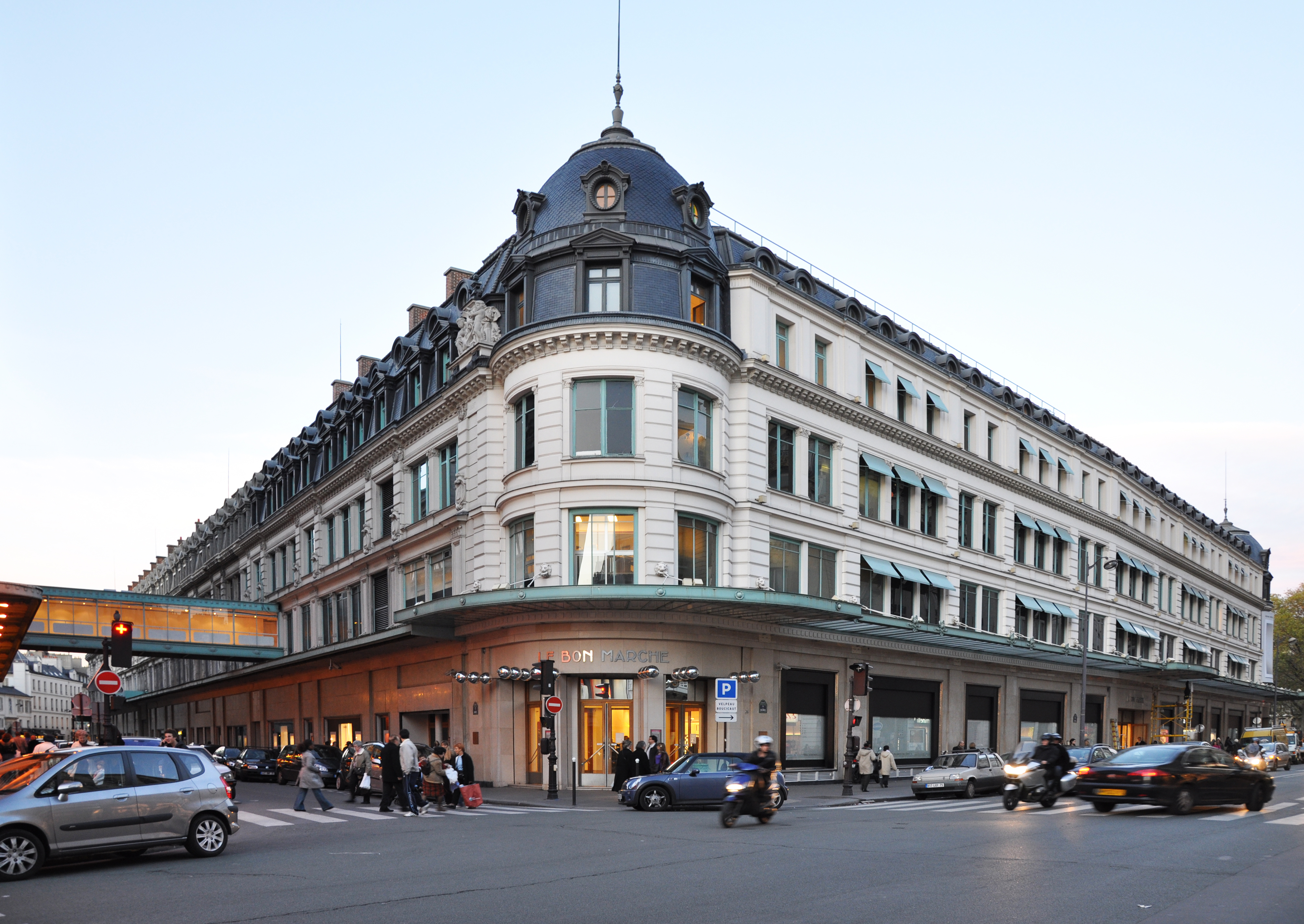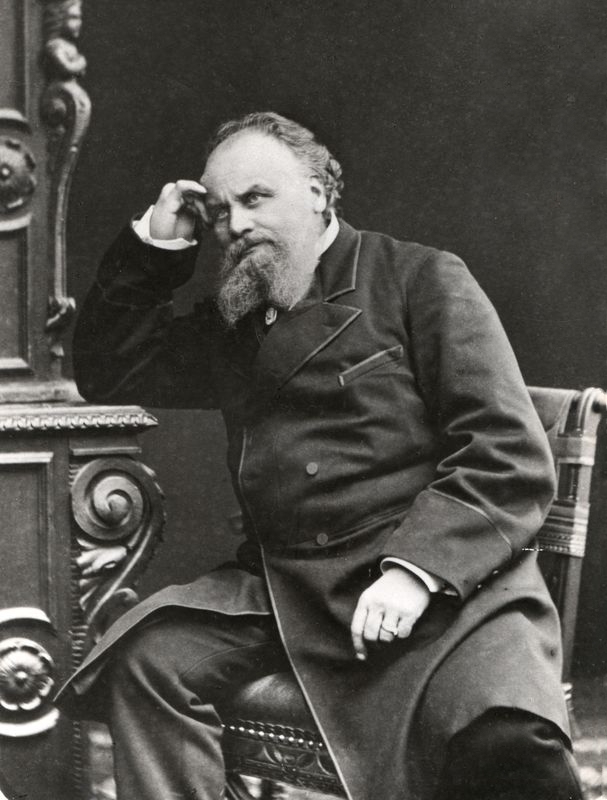Le Bon Marché on:
[Wikipedia]
[Google]
[Amazon]



 Le Bon Marché (lit. "the good market", or "the good deal" in French; ) is a
Le Bon Marché (lit. "the good market", or "the good deal" in French; ) is a
* Byars, Mel. "Follot, Paul" "Pomone," "Guénot, Albert-Lucien," and "Prou, René-Lucien," ''The Design Encyclopedia'', New York: The Museum of Modern Art, 2004, pp. 234, 289, 585, 598–599. * Sennott, R Stephen ed., "Department Store," ''Encyclopedia of 20th-Century Architecture'', New York: Fitzroy Dearborn, vol. 1, A–F, p. 356 * Zola, Émile, '' Au Bonheur des Dames'', Paris: Charpentier, 1883. First serialized in the periodical ''Gil Blas'' and then published as the 11th novel in Zola's Rougon-Macquart series. Is one of Zola's more positive novels about changes in society during the Second Empire; documents the birth of modern retailing and changes in city planning and architecture; considers feminism; deconstructs desire in the marketplace; and tells in a Cinderella format the life of the Boucicauts who, in the novel, appear as Octave Mouret and Denise Baudu. * Michael B. Miller, ''The Bon Marché: Bourgeois Culture and the Department Store, 1869–1920'', Princeton: Princeton University, 1981
Le Bon Marché official website
Cape (with Au Bon Marché label), ca. 1890-1905, in the Staten Island Historical Society Online Collection Database
{{DEFAULTSORT:Bon Marche, Le Buildings and structures in Paris Buildings and structures in the 7th arrondissement of Paris Department stores of France Food halls LVMH brands Shops in Paris



department store
A department store is a retail establishment offering a wide range of consumer goods in different areas of the store, each area ("department") specializing in a product category. In modern major cities, the department store made a dramatic appe ...
in Paris
Paris () is the capital and most populous city of France, with an estimated population of 2,165,423 residents in 2019 in an area of more than 105 km² (41 sq mi), making it the 30th most densely populated city in the world in 2020. Si ...
. Founded in 1838 and revamped almost completely by Aristide Boucicaut in 1852, it was one of the first modern department stores. It was a member of the International Association of Department Stores from 1986 to 2011.
Now the property of LVMH
LVMH Moët Hennessy Louis Vuitton (), commonly known as LVMH, is a French holding multinational corporation and conglomerate specializing in luxury goods, headquartered in Paris. The company was formed in 1987 through the merger of fashion house ...
, it sells a wide range of high-end goods, including food in an adjacent building at 38, rue de Sèvres, called La Grande Épicerie de Paris.
History
A novelty shop called ''Le Bon Marché'' was founded in Paris in 1838 to sell lace, ribbons, sheets, mattresses, buttons, umbrellas and other assorted goods. It originally had four departments, twelve employees, and a floor space of three hundred square meters. The entrepreneur Aristide Boucicaut became a partner in 1852, and changed themarketing
Marketing is the process of exploring, creating, and delivering value to meet the needs of a target market in terms of goods and services; potentially including selection of a target audience; selection of certain attributes or themes to emph ...
plan, instituting fixed prices and guarantees that allowed exchanges and refunds, advertising, and a much wider variety of merchandise. The use of fixed prices replaced the system of haggling over prices, then commonly used in dry goods stores. The annual income of the store increased from 500,000 francs in 1852 to five million in 1860. In 1869 he built a much larger building at 24 rue de Sèvres on the Left Bank, and enlarged the store again in 1872, with help from the engineering firm of Gustave Eiffel
Alexandre Gustave Eiffel (born Bonickhausen dit Eiffel; ; ; 15 December 1832 – 27 December 1923) was a French civil engineer. A graduate of École Centrale des Arts et Manufactures, he made his name with various bridges for the French railway ...
, creator of the Eiffel Tower
The Eiffel Tower ( ; french: links=yes, tour Eiffel ) is a wrought-iron lattice tower on the Champ de Mars in Paris, France. It is named after the engineer Gustave Eiffel, whose company designed and built the tower.
Locally nicknamed ...
. The income rose from twenty million francs in 1870 to 72 million at the time of Boucicaut's death in 1877, at which time the management of the store continued by his wife, Marguerite Boucicaut
Marguerite Boucicaut, ''née'' Guérin (born 3 January 1816 in Verjux, France; died 8 December 1887, Cannes) was a French businesswoman and benefactor. She participated in the creation and prosperity of the first department store, '' Au Bon March ...
. The floor space had increased from three hundred square meters in 1838 to fifty thousand, and the number of employees had increased from twelve in 1838 to 1,788 in 1879. Boucicaut was famous for his marketing innovations; a reading room for husbands while their wives shopped; extensive newspaper advertising; entertainment for children; and six million catalogs sent out to customers. By 1880 half the employees were women; unmarried women employees lived in dormitories on the upper floors.
The architecture
Architecture is the art and technique of designing and building, as distinguished from the skills associated with construction. It is both the process and the product of sketching, conceiving, planning, designing, and constructing buildings ...
of the store was innovative for its time; the 1869 store was constructed by the architect Louis-Auguste Boileau. Alexandre Laplanche ornamented Boileau's ironwork technology. Louis-Charles Boileau
Louis-Charles Boileau (; 1837 - 1914) was a French architect.
He was the son of French architect Louis-Auguste Boileau and the father of French architect Louis-Hippolyte Boileau.. Louis-Charles Boileau was a partner in the design of an extension ...
, his son, continued the store in the 1870s, consulting the firm of Gustave Eiffel
Alexandre Gustave Eiffel (born Bonickhausen dit Eiffel; ; ; 15 December 1832 – 27 December 1923) was a French civil engineer. A graduate of École Centrale des Arts et Manufactures, he made his name with various bridges for the French railway ...
for parts of its structure. Louis-Hippolyte Boileau, the grandson of Louis-Auguste Boileau, worked on an extension to the store in the 1920s.
The building inspired the design of the Bon Marche store in Sydney
Sydney ( ) is the capital city of the state of New South Wales, and the most populous city in both Australia and Oceania. Located on Australia's east coast, the metropolis surrounds Sydney Harbour and extends about towards the Blue Mounta ...
, designed by Arthur Anderson, as well as the Galerias Pacifico shopping centre in Buenos Aires, originally called ''Argentine Bon Marché''.
Zola's novel Au Bonheur des Dames was inspired by the story of Le Bon Marche.
Operations
In 1922, when the decorative arts were at their high point in France, the Pomone design and decorating department was established, following the trend of other Parisian department stores. From 1923 to 1928,Paul Follot
Paul Follot (17 July 1877 – 1941) was a French designer of luxury furniture and decorative art objects before World War I. He was one of the leaders of the Art Deco movement, and had huge influence in France and elsewhere.After the war he became ...
(1877–1941) was its director, followed by René-Lucien Prou (1889–1948) and Albert-Lucien Guénot (1894–1993) up to 1955. Today's home-furnishings inventory primarily consists of brand names but not white goods
A major appliance, also known as a large domestic appliance or large electric appliance or simply a large appliance, large domestic, or large electric, is a non-portable or semi-portable machine used for routine housekeeping tasks such as cookin ...
.
See also
* La Samaritaine *Galerías Pacífico
Galerías Pacífico is a shopping centre in Buenos Aires, Argentina, located at the intersection of Florida Street and Córdoba Avenue.
Overview
The Beaux Arts building was designed by the architects Emilio Agrelo and Roland Le Vacher in 1889 t ...
* Galeries Lafayette
The Galeries Lafayette () is an upmarket French department store chain, the biggest in Europe. Its flagship store is on Boulevard Haussmann in the 9th arrondissement of Paris but it now operates in a number of other locations in France and oth ...
*Foy & Gibson
Foy & Gibson (also known as Foy's) was one of Australia's largest and earliest department store chains. A large range of goods were manufactured and sold by the company including clothing, manchester, leather goods, soft furnishings, furniture, ...
References
Further reading
* Sally Aitken, "Seduction in the City: The Birth of Shopping" (Television Documentary* Byars, Mel. "Follot, Paul" "Pomone," "Guénot, Albert-Lucien," and "Prou, René-Lucien," ''The Design Encyclopedia'', New York: The Museum of Modern Art, 2004, pp. 234, 289, 585, 598–599. * Sennott, R Stephen ed., "Department Store," ''Encyclopedia of 20th-Century Architecture'', New York: Fitzroy Dearborn, vol. 1, A–F, p. 356 * Zola, Émile, '' Au Bonheur des Dames'', Paris: Charpentier, 1883. First serialized in the periodical ''Gil Blas'' and then published as the 11th novel in Zola's Rougon-Macquart series. Is one of Zola's more positive novels about changes in society during the Second Empire; documents the birth of modern retailing and changes in city planning and architecture; considers feminism; deconstructs desire in the marketplace; and tells in a Cinderella format the life of the Boucicauts who, in the novel, appear as Octave Mouret and Denise Baudu. * Michael B. Miller, ''The Bon Marché: Bourgeois Culture and the Department Store, 1869–1920'', Princeton: Princeton University, 1981
External links
*Le Bon Marché official website
Cape (with Au Bon Marché label), ca. 1890-1905, in the Staten Island Historical Society Online Collection Database
{{DEFAULTSORT:Bon Marche, Le Buildings and structures in Paris Buildings and structures in the 7th arrondissement of Paris Department stores of France Food halls LVMH brands Shops in Paris